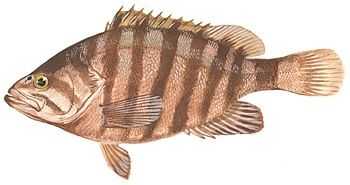Misty Grouper

Species Details
Hyporthodus Mystacinus
Serranidae
Perciformes
Offshore, Deepwater
15 - 119 lbs.
45" - 63"
Misty Grouper (Hyporthodus Mystacinus) Fish Description
Misty Grouper, also known as the Black Grouper, is a ray-finned fish. Meaning, the majority of its fins are soft unlike those that have spines. The Misty Grouper appears robust but compressed from the sides. Their dorsal fins start from the deepest points of their body and cover almost ¾ the length. While the Misty Grouper does have spines, it only has 11 spines on the dorsal fin with 14-15 rays. Its anal fin has 3 spines but 8-9 rays.
Misty Grouper are known for their muddy brown color that makes them invisible in the deep. They have some pale spots but have dark vertical stripes that cover their whole body from their gills to their tail. Misty Grouper also have some stripes across their face but it’s more diagonal in angle. Like most of their Grouper cousins, they also have razor-sharp teeth.
Misty Grouper Diet
Misty Grouper have to use their sharp teeth for something! They’re carnivorous. Their food of preference usually consists of squid, tiny crustaceans, and small fish. It targets crabs, lobsters, and shrimp. Sometimes, you can see them feasting on octopus or small bony fish.
Misty Grouper Size
A Misty Grouper can grow up to an average of 100-115 cm (45 inches). However, there’s a difference between male and female Misty Groupers. A female Misty Grouper can be quite small, reaching up only to 39 inches (100 cm). However, males can reach up to 63 inches (160 cm).
Interesting Facts about the Misty Grouper
- Unlike most fish, Misty Groupers are solitary fish.
- They prefer lurking down below where they can sweep the sand for crustaceans.
- Misty Groupers are deep water fish, usually, they stay at 100 to 400 meters worth of water.
- Misty Groupers do not lash out. Instead, they suck up their prey into their mouths!
- Misty Groupers unleash a suction that allows them to vacuum the shrimp, squid, and crab.
- Misty Grouper don’t chew their food. All their food is swallowed whole!
- Don’t be surprised if you see half-digested shrimp, crab inside their stomachs!
- Surprisingly, these Misty Grouper are a species that’s listed under the Least Concern.
- Possibly because to get a good view of it, one needs to dive deep into the waters.
- The Misty Grouper also goes by another scientific name: Epinephelus mystacinus.
- However, its name changed after witnessing that the Misty Grouper had a deeper body than many of its cousins in the Epinephelus family.
Misty Grouper – Fishing Techniques: How to Fish for a Misty Grouper
When fishing for a Misty Grouper, most anglers would prefer using the Drift Fishing method. The Drift Fishing method is when an angler casts a net to catch the fish. However, this also means that you’ll have to search through a bunch of fish before you actually find the Misty Grouper that you’re looking for.
However, there is a way to fish for them. And that’s to understand their behavior. The first thing to take note of about a Misty Grouper is that they’re solitary, deep water fish. They don’t usually have companions with them. And if they do, it’s probably just a matter of coincidence. Misty Grouper often are aggressive that they do attack other fish. In fact, anglers know members of the Grouper family as a family of vicious strikers. The Misty Grouper may be no different. But because of how deep they are into the water, very few people have actually fished them out.
The next thing to take note of is how they bite. Now, the Misty Grouper isn’t known to bite. Instead, they are known to suck up their prey. They usually devour crabs, shrimps, and smaller fish. So, the pull may not be your typical swipe. Rather, it might feel that something is yanking it downward.
Once you’ve figured that out, start putting on your bait. Shrimp, crab, smaller fish, or small fish will do. Lower the line deep into the water. They do strike more if you’re near reefs and near rocks. But you have to really sink your line all the way to the depths of the water column.
Misty Grouper Habitat and Distribution
Misty Grouper love staying near reefs that are at the bottom of the water column. A water column is what measures the depths of the water. They are measured through the following terms: Epipelagic (surface), mesopelagic (middle), bathypelagic, abyssopelagic, and hadopelagic. Based on their habitat preference, they may be more of the mesopelagic kind of fish. That’s usually around 30-400 meters below.






